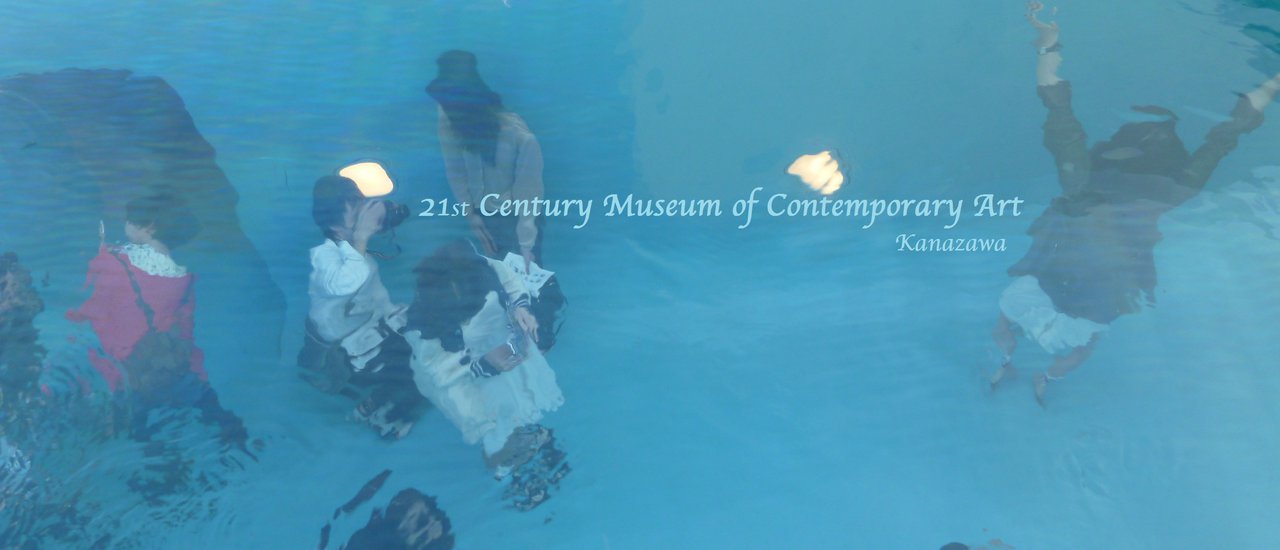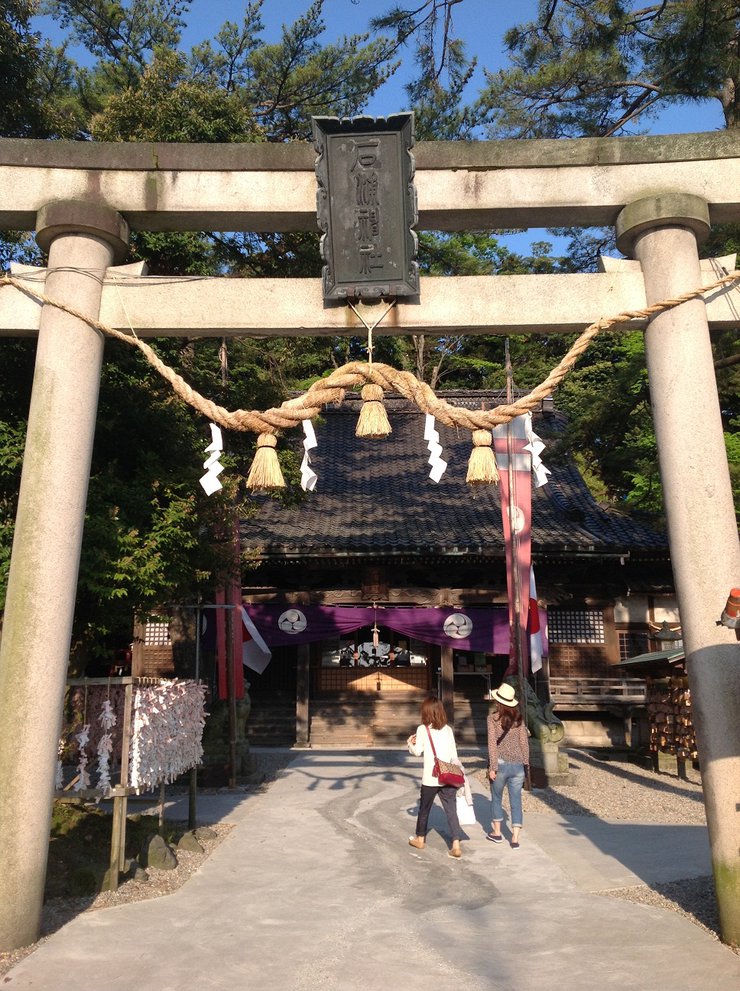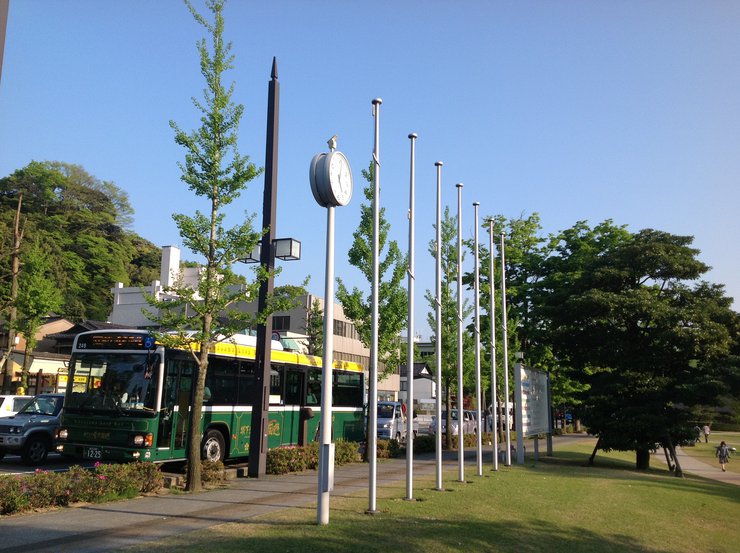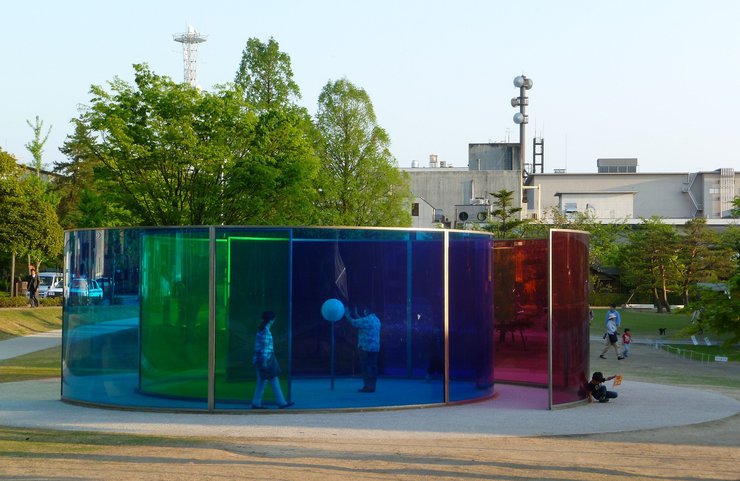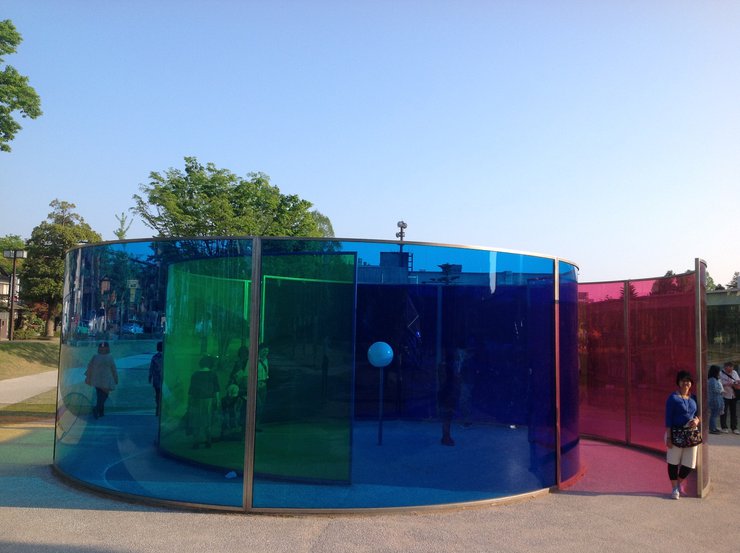Take the Loop Bus from Kanazawa Station for about 20 minutes and get off at the Hirosaka 21st Century Museum (Ishiura Jinja-mae) stop, number RL9. However, we took it from Higashi Chaya Districts (number RL5) for about 10 minutes.

Get off the bus at the Ishiura Jinja-mae bus stop, which is located directly in front of the Ishiura Shrine.

Walk across the street to the museum.

The 21st Century Museum of Contemporary Art, Kanazawa is a new type of art museum that differs in appearance from traditional art museums. It has been open to the public since October 2004.
This art museum is circular in shape, resembling a UFO that has landed on the ground. All the walls are made of glass, and there are five entrances to the building, which look like sections that open out onto the street in all directions.

The front features a curved glass wall in various colors, known as
Colour activity house
Production year: 2010
Media and technique: Laminated colored glass (cyan, magenta, yellow), stainless steel, plastic, lamp
Size: H300cm, ø1,000cm

In Colour activity house, three curved, glass walls, installed around a central outdoor lamp, form a cyclone-shaped pavilion. The pavilion draws conceptually on the subtractive colour model CMYK, with each wall consisting of glass tinted in one of three primary colours, either cyan, magenta, or yellow. Depending on the viewer's position within the pavilion as well as his or her degree of movement, the regions of colour created by the walls mix together and produce various hues. The pavilion's engagements with its surroundings are myriad. From within the folds of the pavilion, visitors look out onto a tinted urban environment, while externally, its glass walls present hued reflections to passers-by – both effects transforming the everyday scenery into a polychromatic cityscape. When the sun sets, the lamp at the centre illuminates the pavilion, turning the artwork into a lighthouse of colours and emphasising the spectrum of tints created by its glass walls.

This museum showcases experimental contemporary art, where visitors can touch or sit on the exhibits. There is also an area where visitors can enjoy the art without paying an entrance fee (chairs in front of the museum, along the road).

The front area has a stainless steel mesh that allows children to play in, called
Wrapping
Production year: 2005
Media and technique: stainless steel
Size: H677 ×W754×D397cm

This pavilion, built on the lawn surrounding the museum, is designed to allow children to enter and play inside. It takes a complex shape, resembling a balloon pushed out in six different directions from the inside. Three of the six projections touch the ground at their ends and support the overall structure while serving as entrances. By making the pavilion transparent using pipes and wire mesh, the architect has created an image of lightness that makes the structure's large size unnoticeable.

Walk inside the building and you will find colorful chairs where you can sit and take pictures.
People's Gallery 09.10.04-21.03.05
Production year: 2004
Media and technique: acrylic paint / Chairs:
Michael Lin in collaboration with Kazuyo Sejima + Ryue Nishizawa / SANAA
Size: (wall) H395.5 × W2,744cm, (each of 15 chairs) H87 ×W46×D76cm

In the creation of this work, Michael Lin resided in Kanazawa and visited artisan studios to research the history and techniques of Kaga Yuzen kimono fabric dyeing. The floral pattern he conceived as a result now covers an entire wall of the Museum's bright, sunlit People's Gallery. The same pattern adorns the surface of the rocking chairs designed by SANAA that are situated before the wall. Lin's work exudes a cheerful, robust energy that transcends the framework of wall and chairs and asserts its own presence, seemingly eroding the neutral white spaces of the Museum.


Sitting on a chair and looking out, you will see a statue of a man standing measuring the clouds, on top of the building.
The Man Who Measures the Clouds
Production year: 1998
Media and technique: bronze
Size: H285 ×W120×D80cm
This work was inspired by Birdman of Alcatraz (1961, USA), a film based on the true story of a man who kept birds in his cell while imprisoned in solitary confinement and became an ornithologist. At the film's end, when the man, who has been denied permission to continue his research, is asked about his future plans, he replies: "I am going to measure the clouds." The artwork takes its title from this line. Although modeled after the artist himself, The Man Who Measures the Clouds also pays homage to his late twin brother. It is thus a work blending various elements—human life and death, natural science, and the poetic gesture of "measuring the clouds."

Rows of rabbit-shaped chairs are arranged along the wall.


Exhibition poster to be displayed

Today there is an exhibition of dog architecture. Photography is not allowed inside.

This dog architecture was photographed before the no-photography sign was seen.

Paper Workshop


Hydraulic piston lifts move up and down.

A unique feature of this museum is its commissioned artwork, such as pieces that are integrated into the building itself. These include installations that make visitors feel as if they are standing under a swimming pool (The Swimming Pool).

The Swimming Pool
Year of production: 2004
Media and technique: concrete, glass
Dimensions: H280 ×W402×D697cm

In one of the museum's courtyards, a swimming pool framed by a limestone deck invites visitors to a unique experience. From the deck, the pool appears to be filled with deep, shimmering water. However, a closer look reveals a layer of water only 10cm deep suspended over transparent glass. Below the glass lies an empty space with aquamarine walls, accessible to viewers. This work creates a sequence of experiences, from the initial surprise of seeing people seemingly underwater to the upward gaze from within the pool. By challenging our assumptions about the obvious, the work invites active participation and fosters a sense of connection between those observing each other.




Open: 10:00 AM - 6:00 PM (Friday and Saturday close at 8:00 PM)
Closed: Mondays (or the following day if Monday is a national holiday) and December 27th to January 1st.
The public area is free to enter and is open from 9:00 AM to 10:00 PM.
Admission fees vary depending on the exhibition, but are typically around 1,000 yen.
Information from the Museum website: https://www.kanazawa21.jp/en/
This review is part of the Snow Wall trip. Traveling by Airasia
Day 1 Arrive at Narita Airport at 7:00 PM. We sent some luggage to Takayama and stayed at Narita airport resthouse tonight.
Day 2 We exchanged train tickets at Tokyo Station and took a bus from Shinjuku to stay and visit the castle Matsumoto
Day 3 We went to Japan Alpine early in the morning, visited the dam, took the cable car to the snow wall, and spent the whole day there. Then we went to sleep in Toyama.
Day 4 In the morning, we visited Toyama Castle. In the afternoon, we went to Hida Furukawa. In the evening, we went to stay and ride a bicycle to visit Takayama
Day 5 In the morning, we went hiking at Kamikochi. Then we came back to take a car and walk around Takayama
Day 6 We left early in the morning to walk around Shirakawako for half a day. In the afternoon, we went to visit Kanazawa.
We went to Higashi Chaya Districs and then to 21st Century Museum of Contemporary Art
Day 7 In the morning, we visited Kenrokuen Garden and Kanazawa Castle. In the afternoon, we traveled to Osaka.
Day 8 In the morning, we visited Nara. In the afternoon, we came back to Osaka for shopping before returning tonight.
Wit Sil
Friday, September 27, 2024 10:19 AM

